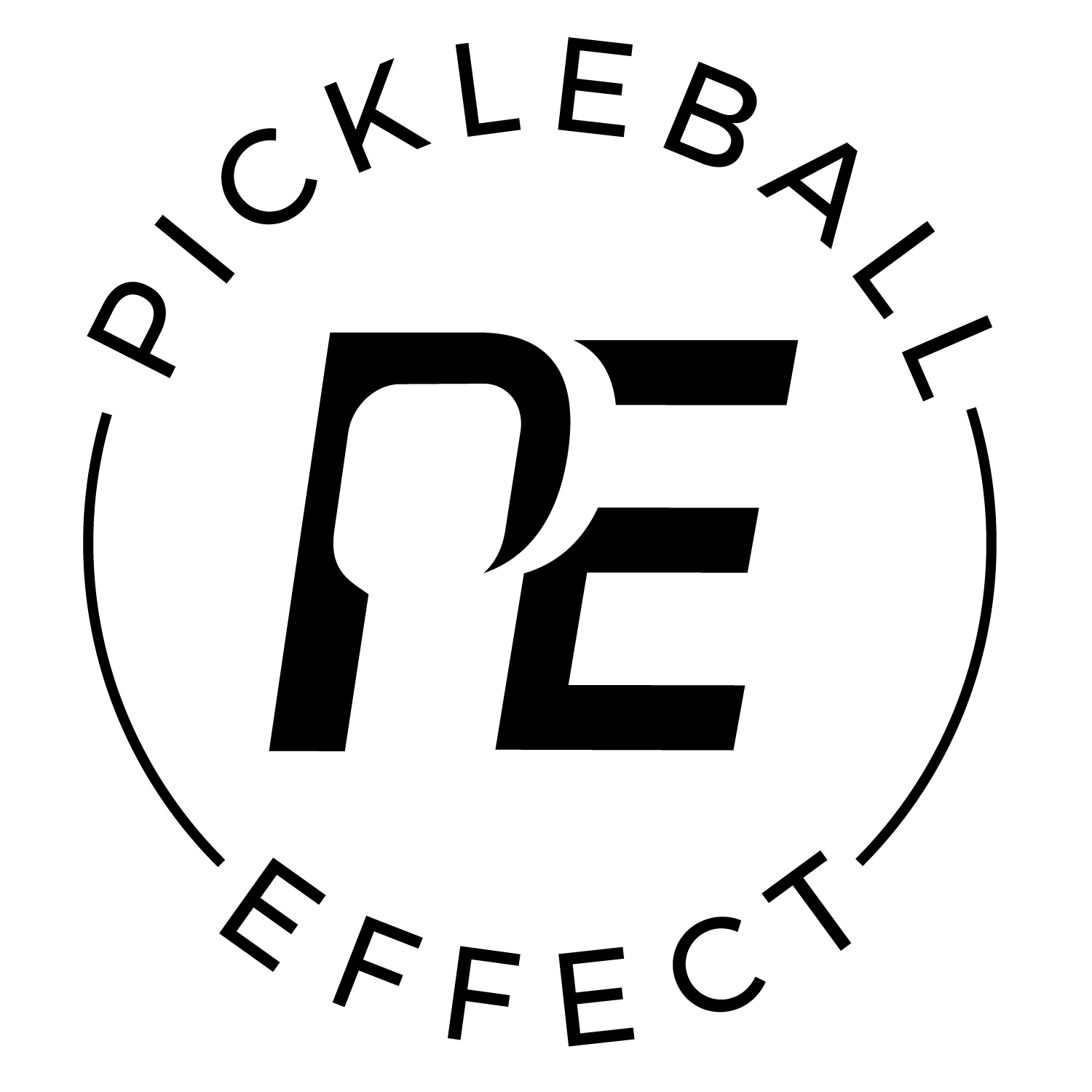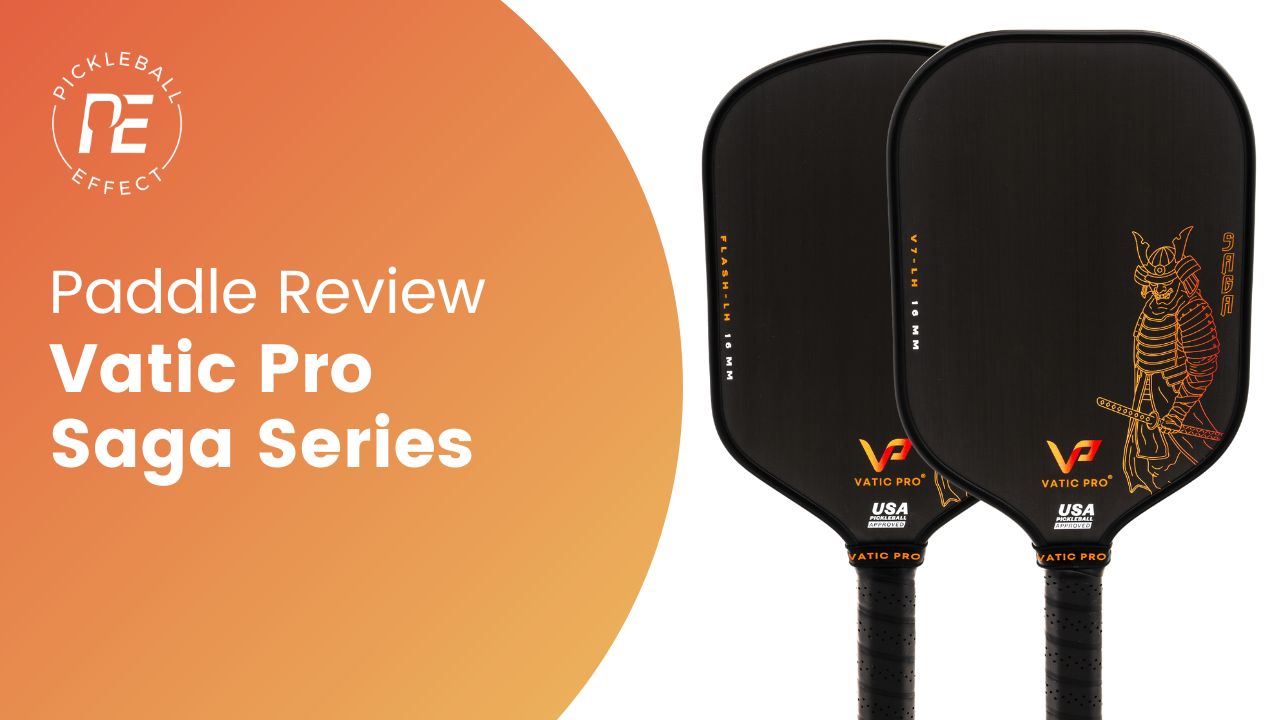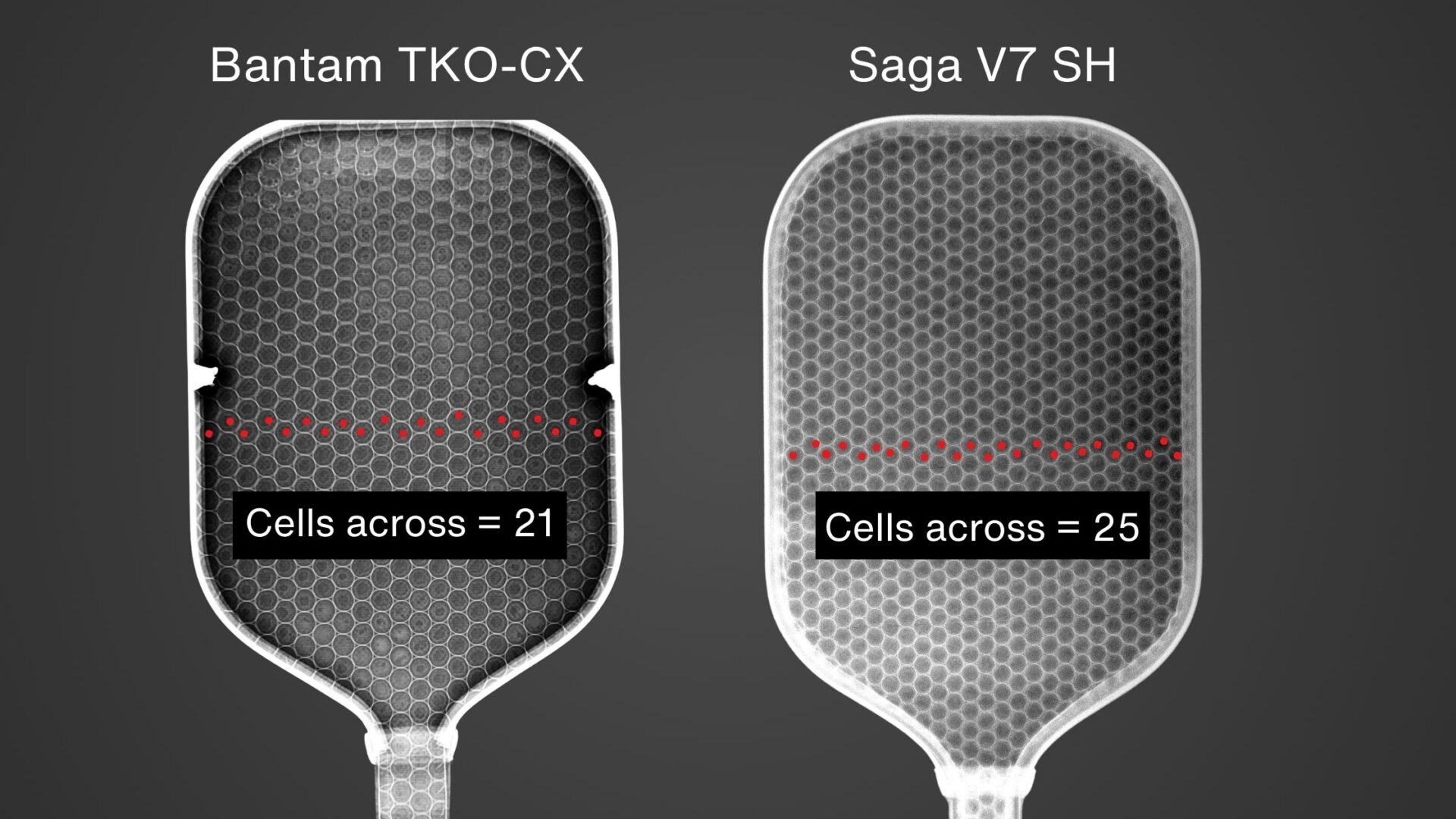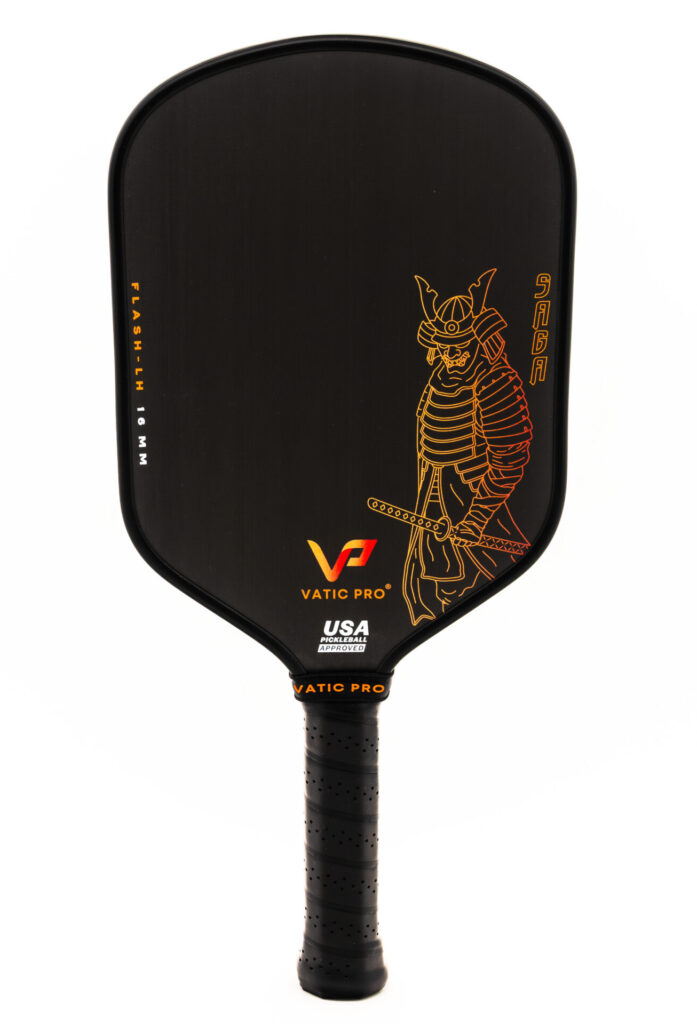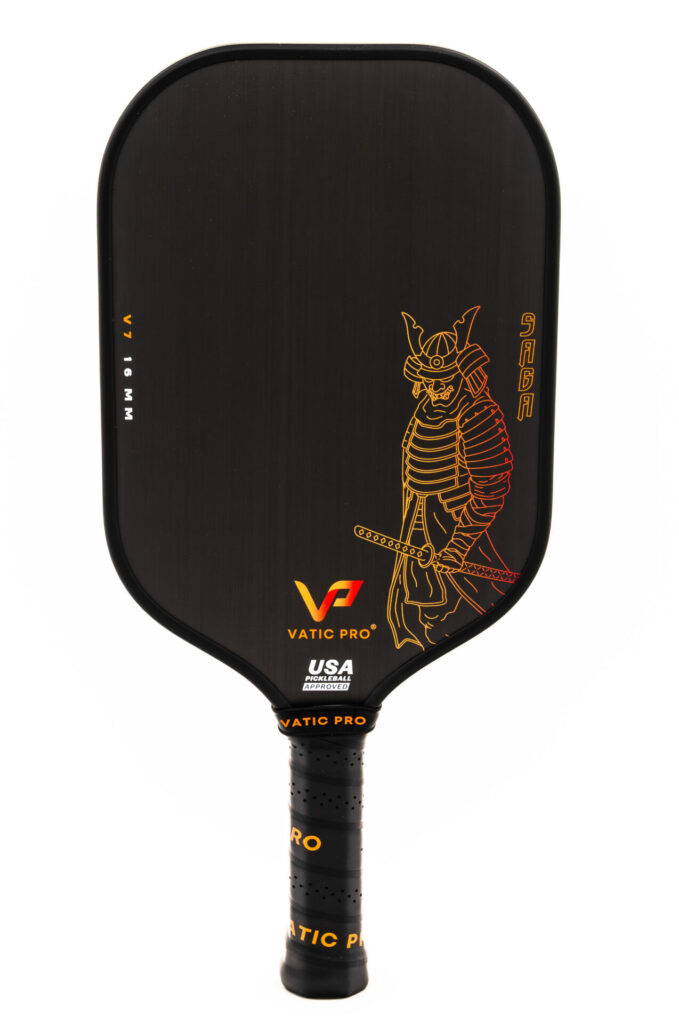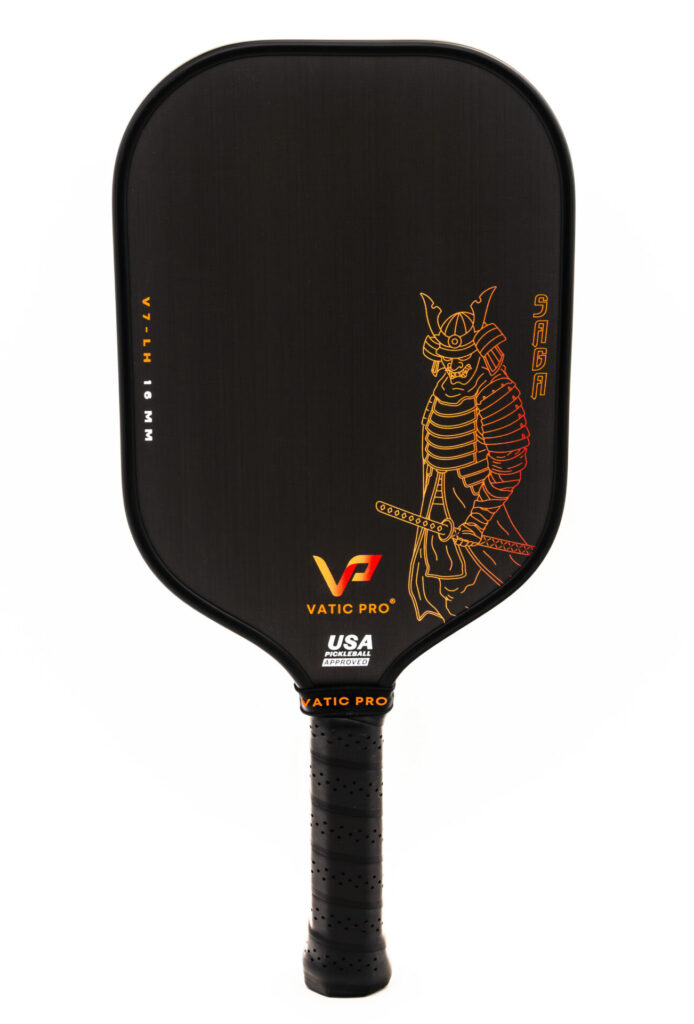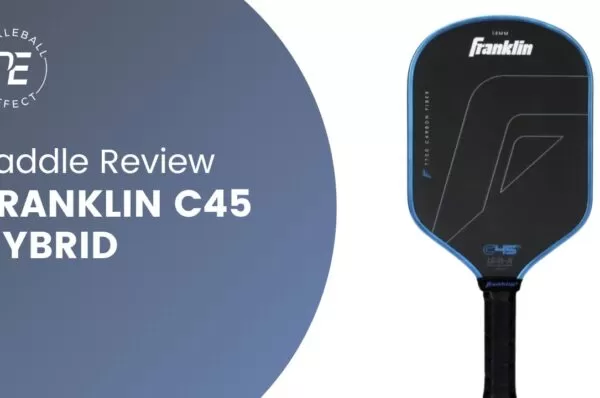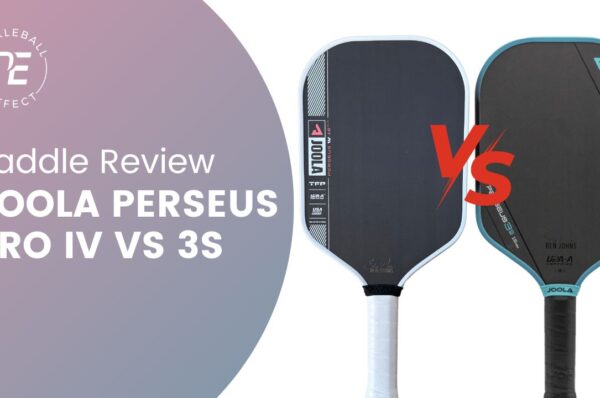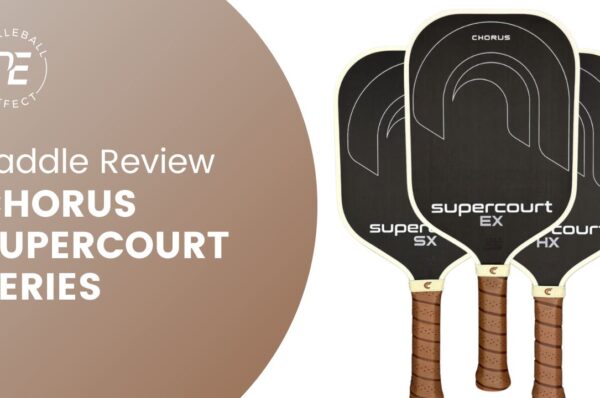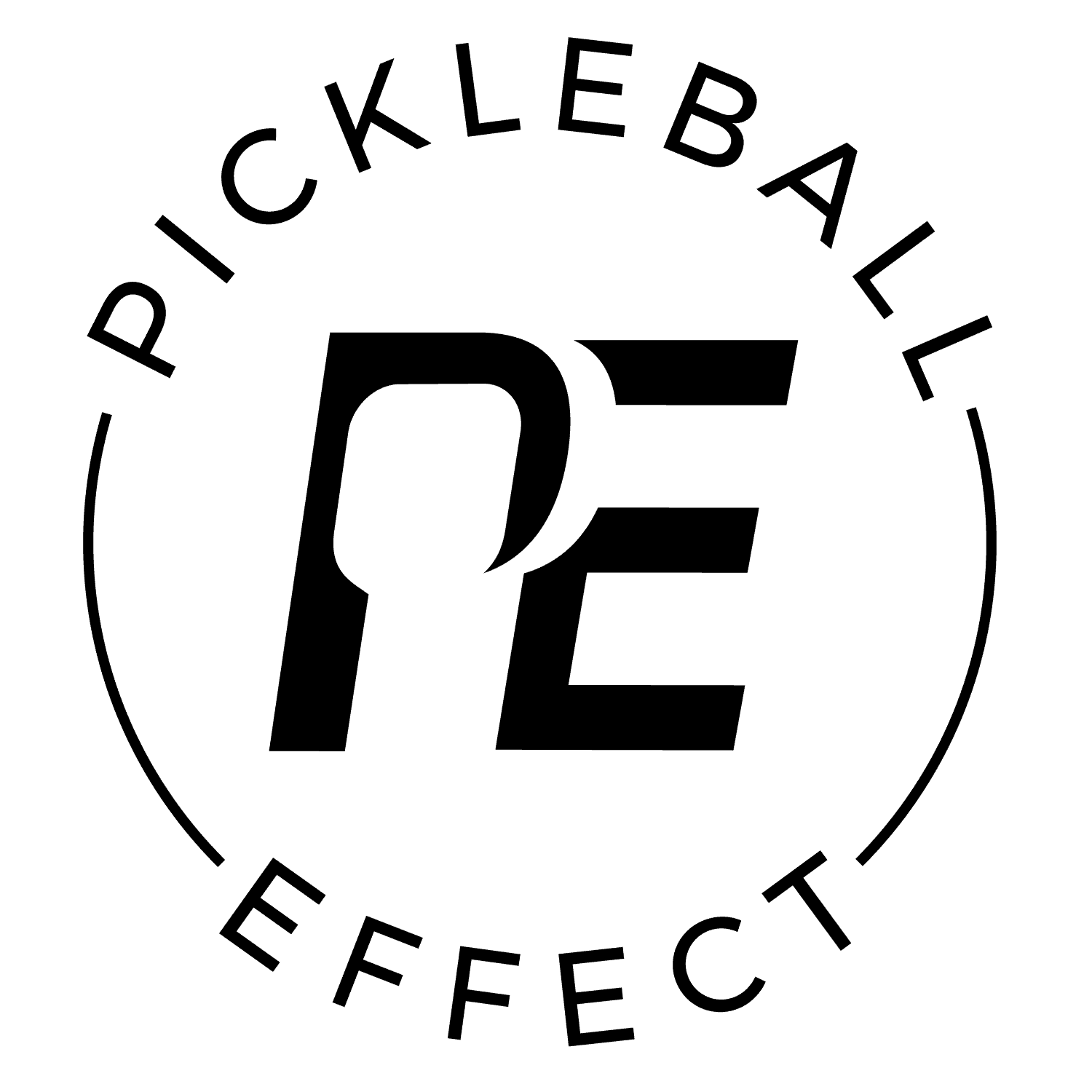Vatic Pro is known for their budget friendly performance level paddles and I see them as one of the leaders in that space. While they have great paddles and I recommend them often, what they don’t have is a power paddle. This release of their Saga series was designed to fill in that gap. While the paddles in the series do have some power, it’s not your typical power paddle profile. It has bigger power levels but medium to low pop levels which makes for this interesting combination where you can control the paddle as well as most control paddles but you get more power from it when you swing bigger.
The series is offered in two shapes, their Flash (hybrid) and their V7 (elongated) options, and then two handle length choices for each shape. A Standard Handle or SH at 5.3” and a Long Handle or LH at 5.6”. For the release on 11/15/24 the paddles will only be available in a 16mm width.
Sticking with their budget friendly prices, the paddles retail for $150 and if you use my code 10EFFECT on their website it’ll give you $10 off and I get a small commission to help support my review efforts. Vatic Pro did send me these paddles for free but no money was exchanged and no promise was made for a review. These thoughts are my own and as with all my reviews I am as unbiased as possible and explain the pros and cons of the paddle through my play testing experience and the data I collect.
For this review I’ll talk about the technology they used, the general performance of the series, and then I’ll break down the performance nuances for each shape.
(Get $10 off with the discount code 10EFFECT on Vatic Pro’s website)
Table of Contents
Vatic Pro Saga Series Technology
While most power-type paddles typically incorporate additional foam in the core combined with thermoforming to enhance power, Vatic Pro has taken a different approach. Their design somewhat mirrors that of the popular Paddletek Bantam series, it’s not thermoformed and utilizes a blend of carbon fiber and composite materials in the face alongside a wider 10mm cell honeycomb core (compared to the common 8mm or 6mm cells). These components work together to boost power, showcasing a technique that other brands are likely to adopt in the future.
However, while Vatic Pro claims a 10mm core cell size, X-Rays show that the cells on the Paddletek Bantam TKO-CX (which shares a 7.5″ head width with the Saga V7) appear larger. See image above. Counting the cells across the paddles’ width reveals 21 cells on the Bantam and 25 on the Saga. You can also notice that the cell walls are thicker on the Saga than the Bantam. The Bantam’s X-ray was provided by my fellow reviewer, John Kew, and the Saga’s X-ray was obtained by me.
I discussed the cell size discrepancies with the owner of Vatic Pro, who mentioned his measurement method likely differs from Paddletek’s; he measures from the middle of the cell wall while Paddletek measures the cell opening. He estimates Paddletek’s cells are 12mm and his at 10mm using his method. Despite these differences, Vatic Pro’s new cores feature wider cells than they have previously used. I think this also shows that Vatic Pro isn’t just copying Paddletek, it’s their own design.
Lastly, these paddles are not thermoformed, which enhances the paddle’s longevity and prevents significant performance changes over time, often seen in paddles with more foam in the core. This means there are fewer chances of core crush or foam loosening, preventing the paddle from becoming too “hot.” The key distinctions from Paddletek’s paddles lie in the 16mm thickness and the normal foam injection around the entire perimeter of the Vatic Pro paddles. Both features expand the paddle’s sweet spot but reduce pop.
Saga Series Performance Review Summary
Power & Pop: As I mentioned before, the paddles have a higher power and medium to low pop profile. I haven’t played with another paddle that has such a big gap between the power and pop. My serve speed tests for the Flash SH model were coming in just under the Paddletek TKO-C 14.3 which is known for having bigger power while the V7 SH model was on par with it. This is the high 80 and low 90 percentiles in my paddle database. When you lay into a drive, serve, or overhead you find the power there but it otherwise behaves like a control paddle because it doesn’t have the pop that typically accompanies a paddle with this much power. My pop tests were putting the paddles in the 30th percentile in my paddle database which is the same ballpark as a Six Zero Ruby. It’s more pop than Vatic Pro’s Prism series but it’s not dramatically more. Very similar level of pop as Vatic Pro’s original orange series which is a softer thermoformed paddle.
While the medium to low pop did make it easier to control in many situations, there were times I wished it was giving me more on counters and since the paddles are mid to high weighted paddles I lost some offensive ability at the net since I wasn’t particularly fast and my counters were toned down.
The paddle has a muted feel to it and it doesn’t sound or feel like the ball explodes off the paddle. So if you base your judgment off feel and sound it doesn’t seem like you hit it very hard but when you hit drives with it next to other paddles you can see the power in the Sagas versus the others.
Last thing I’ll say here is that in order to find the power you have to bring some of your own strength. If you don’t have much physical strength of your own then you won’t find the power in this paddle like I did. There are other paddles out there like the JOOLA 3S series or the Paddletek Bantams that give you more power with less effort. The Vatic Pro Sagas require more effort to get the power. Most players will naturally have enough strength in their swing to find it but there are cases that won’t be true.
Control & Feel: The paddles absorb pace for you on resets and dinks as if they were control paddles, making it easier to work your way to the net and place your shots. You even have to swing a little more to generate enough pace on the ball to clear the net on thirds. The paddle has a muted feel and a softer, thud-like sensation that isn’t exactly plush but feels comfortable and solid without any unwanted vibrations.
Even when I was being attacked by players who could really smoke the ball, I could absorb the pace well from their shots as if it was a control paddle. The power hidden in the paddle only manifested itself when I was swinging big, not when the ball was moving faster toward me, such as when I was in a defensive position. This also meant that defending drives with a simple block didn’t add much pace either and it was harder to keep the ball deep in that scenario. Overall, the muted nature and mid-weight to heavy-weight design of the paddles enhanced your ability to control the ball and smooth out your swing for improved consistency.
Forgiveness & Spin: Forgiveness wise they play much more forgiving than the Paddletek Bantam TKO 14.3 paddle and it is more lively around the throat and top of the paddle like a thermoformed paddle is though it doesn’t have an exaggerated sweet spot from side to side and is more average there. My spin tests were coming in the mid to high 1900s which is good though not the highest I’ve ever measured. The spin seemed available from all over the court and there weren’t any concerns there. The paddles gather a lot of ball dust when you play with them so be sure to have a paddle eraser.
(Get $10 off with the discount code 10EFFECT on Vatic Pro’s website)
Individual Saga Paddle Reviews
There wasn’t as much performance variation between each option in this series as there is in most others. The biggest difference between each paddle performance wise was swingweight. Picking the best option for you primarily depends on your preferred swingweight and then handle length second.
Saga Flash SH Review
- Static Weight: 8.0-8.3 oz avg
- Swingweight: 114-116 (medium)
- Twistweight: 6.4 (average)
- Spin RPMs: 1961 (high)
- Length x Width: 16.3″ x 7.7″ (hybrid)
- Face: Carbon/composite mix
- Grip Circumference: 4.125″
- Handle Length: 5.3″
- Core: 10mm wide cell poly honeycomb
- Special Features: Foam edge, not thermoformed
- Paddle Type: All-Court
- Price: $149.99 ($139.99 with code 10EFFECT)
- Warranty: 180 day warranty – learn more
(Get $10 off with the discount code 10EFFECT on Vatic Pro’s website)
Vatic Pro gained some of their popularity by being one of the first to come out with a hybrid shape like the Flash model. It’s a good shape that gives you some extra reach without giving up too much sweet spot. It’s the lightest swingweight option in the series. My unit measured 114 which falls into the lighter midweight category. It’s light enough that you can still customize it with some tungsten tape without it getting away from you. It gives you a little less power than the others in the series but it’s not far behind. This shape and weight appeals to the largest audience and will likely be their best seller of the group.
I’m 6’2” and have slender hands and I’m able to fit two hands on the 5.3” handle well enough when I need to but if you have larger hands then this handle will be too short for that and you’ll want the LH version.
Saga Flash LH Review
- Static Weight: 8.0-8.3 oz avg
- Swingweight: 116-120 (medium-high)
- Twistweight: 6.3 (average)
- Spin RPMs: 1961 (high)
- Length x Width: 16.5″ x 7.5″ (elongated)
- Face: Carbon/composite mix
- Grip Circumference: 4.125″
- Handle Length: 5.6″
- Core: 10mm wide cell poly honeycomb
- Special Features: Foam edge, not thermoformed
- Paddle Type: All-Court
- Price: $149.99 ($139.99 with code 10EFFECT)
- Warranty: 180 day warranty – learn more
(Get $10 off with the discount code 10EFFECT on Vatic Pro’s website)
The Flash LH is longer and more narrow than the Flash SH; it’s an elongated paddle, while the Flash SH is a true hybrid. I don’t know why they did this, I wish it was the same length and width as the other Flash but with a longer handle. However, despite this, the Flash LH offers a more manageable swingweight than the elongated V7 LH, making it the better choice for those seeking an elongated paddle with a longer handle because the V7 LH has a huge swingweight that is tough to manage.
My Flash LH unit had a 120 swingweight. It certainly felt heavier and was a little more cumbersome to move at the net but there was more power with this vs the SH and your strokes felt smoother. If I were to main this paddle I’d add a Slyce cap to it to improve maneuverability at the net.
Saga V7 SH Review
- Static Weight: 8.2-8.5 oz avg
- Swingweight: 120-123 (high)
- Twistweight: 6.6 (above average)
- Spin RPMs: 1954 (high)
- Length x Width: 16.5″ x 7.5″ (elongated)
- Face: Carbon/composite mix
- Grip Circumference: 4.125″
- Handle Length: 5.3″
- Core: 10mm wide cell poly honeycomb
- Special Features: Foam edge, not thermoformed
- Paddle Type: All-Court
- Price: $149.99 ($139.99 with code 10EFFECT)
- Warranty: 180 day warranty – learn more
(Get $10 off with the discount code 10EFFECT on Vatic Pro’s website)
There aren’t as many elongated paddles these days that have handle length options under 5.5” like the V7 SH does. While there are less players that prefer shorter handles there is still a place for them so I like that they have this option. If you don’t play any two handed shots then I don’t think it’s necessary to get the LH options in the series. The SH will give you more paddle surface and a longer sweet spot from top to bottom.
The swingweight on this is higher around 120 but that’s still within reason. If you like this shape but are nervous about the swingwieght being too high then I’d say either put on a Slyce cap or get the Flash SH version for the lighter swingweight.
This paddle played and felt very similar to the Flash LH but just with a shorter handle. If you want an elongated shape from this series then I’d pick between this one and the Flash LH because the V7 LH is too heavy.
Saga V7 LH Review
- Static Weight: 8.2-8.5 oz avg
- Swingweight: 124-126 (high)
- Twistweight: 6.6 (above average)
- Spin RPMs: 1954 (high)
- Length x Width: 16.5″ x 7.5″ (elongated)
- Face: Carbon/composite mix
- Grip Circumference: 4.125″
- Handle Length: 5.6″
- Core: 10mm wide cell poly honeycomb
- Special Features: Foam edge, not thermoformed
- Paddle Type: All-Court
- Price: $149.99 ($139.99 with code 10EFFECT)
- Warranty: 180 day warranty – learn more
(Get $10 off with the discount code 10EFFECT on Vatic Pro’s website)
This one is very heavy with its 125 swingweight and since you have the Flash LH that is the same height, width and handle length but with a more manageable swingweight it doesn’t make sense to pick this one to me. If you really do like this weight then I’d still get the Flash LH and then just add my own weight to it.
Paddle Comparisons
Given the expected popularity of the Saga Flash SH in this series, I will contrast this paddle with other comparable options on the market for further context.
Vatic Pro Prism Flash 16mm: The Saga Flash offers a greater increase in power compared to the Prism, and while it also provides more pop, the difference in power is more significant than that of the pop. The Prism feels denser by comparison, yet both paddles offer similar levels of forgiveness. Check out the paddle here >>
Vatic Pro Flash 16mm (orange model): The Saga Flash boasts more power and a pop level comparable to the original Flash. Ranking them based on pop, the original Flash has a slight edge. The original Flash feels somewhat stiffer and is marginally more forgiving laterally than the Saga. Check out the paddle here >>
Honolulu J2K 16mm: The Saga Flash has greater power but less pop than the J2K, and it doesn’t feel as stiff. Conversely, the J2K provides a wider sweet spot from side to side. Check out the paddle here >>
Six Zero Double Black Diamond (DBD) 16mm: The Saga Flash possesses more power with just a bit less pop than the DBD. The DBD has a crisper feel in contrast to the more muted sensation of the Saga Flash. The sweet spot edge goes to the DBD, but the distinction is minimal. Check out the paddle here >>
You can use the discount code 10EFFECT on any of those websites for a discount.
My Recommendation
Who is the Saga good for? These paddles are a good choice for players who prefer or need control-oriented paddles to help their soft game but also need additional support with their drives and put-aways, without compromising the control necessary for drops, dinks, and resets. There high power and low pop profile that does that also makes them particularly suitable for intermediate players, enabling them to aggressively finish points and simultaneously reducing errors. A win win.
Who is the Saga not good for? Advanced players may find these paddles lacking the pop needed for effective counters. Additionally, those who prefer lighter paddles will need to opt for the Flash SH, as it is the only mid weight option within this range, with the rest being on the heavier side.
(Get $10 off with the discount code 10EFFECT on Vatic Pro’s website)
Braydon competes at the 5.0 level and plays in 5-10 tournaments a year. He plays/drills 3 to 4 times a week and would play more if time allowed it.

Paddle Terms Glossary
We’ve categorized paddles into three categories. Control, All-Court, and Power. Paddle categories are determined by Braydon after he hits or reviews the paddle.
- Control paddles offer a softer feel and better absorbs pace off the ball but doesn’t give you as much power.
- All-Court paddles give you a blend of power and control and does well at everything though it doesn’t excel at anything.
- Power paddles often have a firmer feel and will return more power but are harder to control.
A paddle’s weight represents the inherent mass of the paddle as measured on a scale. However, relying solely on this static weight measurement can be misleading when assessing the true perceived heaviness of the paddle. Even if two paddles both clock in at 8 oz, their actual heft in your hand can markedly differ due to variations in weight distribution within the paddle. This is why the static weight should be considered with the swingweight of the paddle. See the definition of swingweight below.
The weight value listed in the database corresponds to the paddle’s weight that I used to gather the swingweight and twistweight measurement. It’s possible that if your paddle has a different static weight than then the swingweight and twistweight may be slightly different.
There are three primary shapes a paddle can have which consists of the length and width of the paddle. These three shapes are:
- Elongated: The dimensions for an elongated paddle are 16.5″ x 7.5″.
- Standard: A standard shaped paddle has dimensions of 16″ x 8″.
- Hybrid: A hybrid shaped paddle falls somewhere in between the standard and elongated shapes, with approximate dimensions of 16.25″ x 7.5″-7.7″.
Then there are two less common shapes you’ll see. These are:
- Extra-Elongated: This shape is 17″ x 7″
- Widebody: This any paddle shorter than 16″ long.
When considering the advantages and trade-offs of paddle shapes, it’s important to understand the characteristics of each shape.
- Elongated Paddle: An elongated paddle offers increased reach, spin, and power. However, this additional reach comes at the expense of forgiveness, particularly from side-to-side.
- Standard Paddle: In contrast, a standard-shaped paddle provides less reach and a little less power & spin but offers greater overall forgiveness. This means that while you may not have the same extended reach as an elongated paddle, you gain better control and stability.
- Hybrid Paddle: The hybrid shape serves as a middle ground between the elongated and standard shapes. It provides a balance between reach and forgiveness, offering players a versatile option that combines aspects of both shapes.
It’s interesting to note that advanced players often prefer elongated shapes. On the other hand, players at lower skill levels typically opt for the extra forgiveness offered by standard shaped paddles.
Ultimately, the choice of paddle shape depends on an individual’s playing style, preferences, and skill level. Whether your focus is on reach or forgiveness, understanding the unique benefits and trade-offs of each shape can assist you in selecting the paddle that best suits your game.
Swingweight is a measure of the paddle’s resistance to swinging about the end of the handle. The higher the swingweight number the heavier it will feel in your hands. A higher swingweight has more power but is harder to swing, lower swingweight is easier to swing but has less power. Sometimes a faster swing with a lower swingweight can make up for power lost in swingweight. The price paid for that is greater impact shock. Stock swingweights will vary between 100 – 140.
Twistweight is the resistance to rotating around the long axis through the middle of the paddle from butt to tip. The higher the twistweight the more resistance the paddle has to rotating on off center hits. This measurement is closely related to the amount of forgiveness or the size of the sweet spot of the paddle. A higher twistweight indicates a bigger sweet spot. Twistweight numbers range from 5 – 8.
Measuring the revolutions per minute (RPMs) off of a serve you get a number that shows the spin potential of a paddle. Using these RPM measurements I’ve created five buckets that a paddle will fall into indicating its overall spin potential. The five buckets are:
1900 or Higher = Very High
1700 – 1900 = High
1500 – 1700 = Medium
1300 – 1500 = Low
1300 or less = Very Low
You can tell a big difference in the amount of spin a paddle generates when you compare a Very High paddle to a low paddle. But the gains from Medium to High to Very High are marginal. We’ve found that having at least a medium rating is often enough if you’re looking for a good spin paddle. However, if you’re a big hitter then you will benefit more from a high spin paddle to help you keep the ball in play more often.
The power level of a paddle is shown in miles per hour (MPH) after taking ten measurements with a speed gun of hitting a serve as hard as I can. This measurement gives you an idea of how hard you can hit the ball when given the chance to take a full swing. So shots like serves, drives and overheads. The higher the MPH reading the more power you can generate with the paddle.
I also show the percentile ranking of the measurement to give you an idea of how it stacks up against the rest of the paddles in my database.
The pop level of a paddle is shown in miles per hour (MPH) after taking the average of ten speed gun measurements of hitting a punch volley as hard as I can. This measurement gives you an idea of how hard you can hit the ball on shorter swings and gives you an idea of how quickly a ball comes off the face when you apply less force on the ball. So shots volleys, dinks, counters, and resets are all affected by the pop measurement. The higher the pop measurement the stronger your counters will be but it takes more skill to keep the ball from floating or popping up on you when resetting a hard hit ball or when dinking.
I also show the percentile ranking of the measurement to give you an idea of how it stacks up against the rest of the paddles in my database.
The term “forgiveness” pertains to both the size of the sweet spot and the stability of the paddle. A paddle that is more forgiving offers a larger sweet spot, greater stability, and yields more power when hitting off-center shots. On the other hand, a less forgiving paddle has a smaller sweet spot and does not provide as much power when hitting off-center shots.
While there seems to be only benefits of more forgiving paddles, less forgiving paddles are often more maneuverable and is easier to generate more paddle speed.
